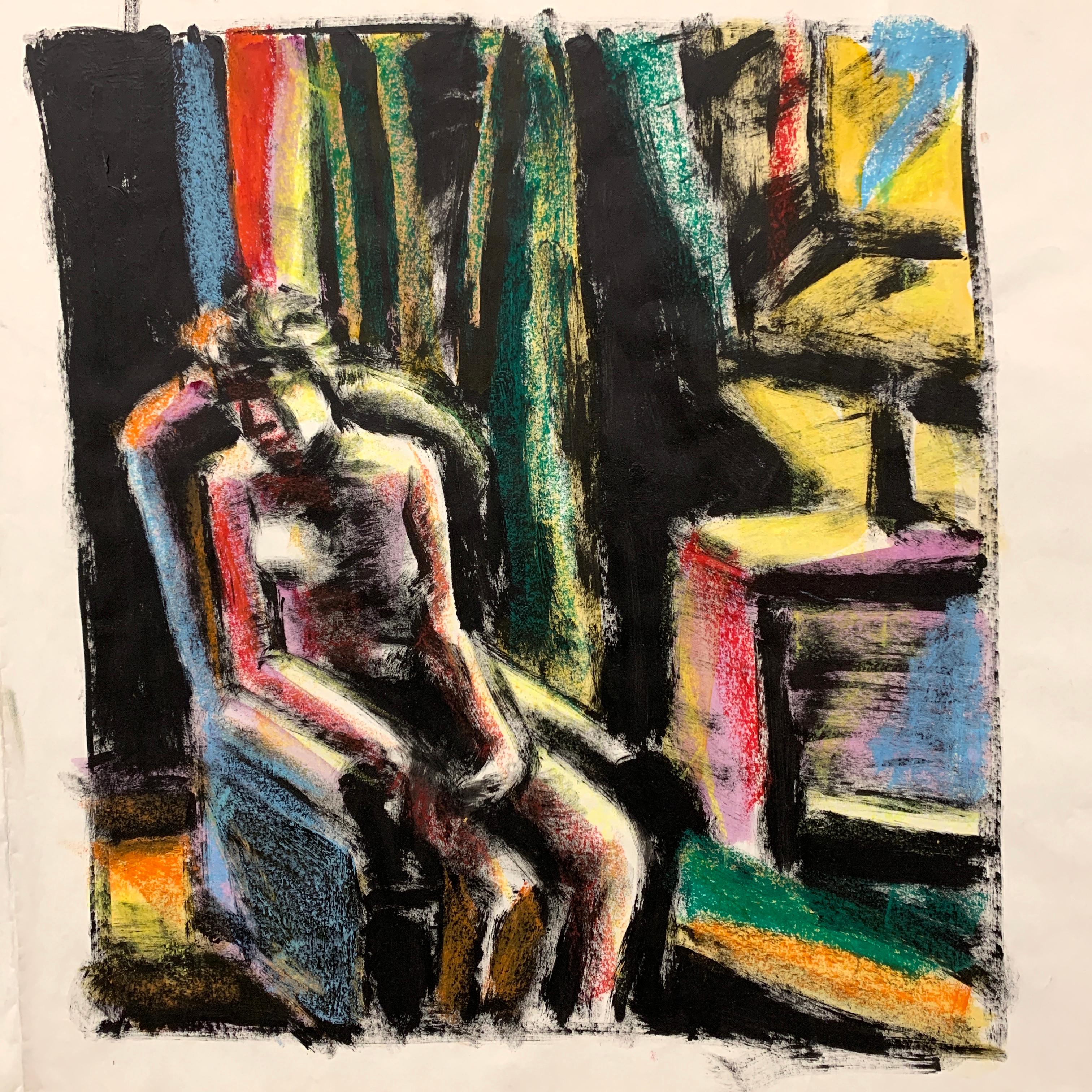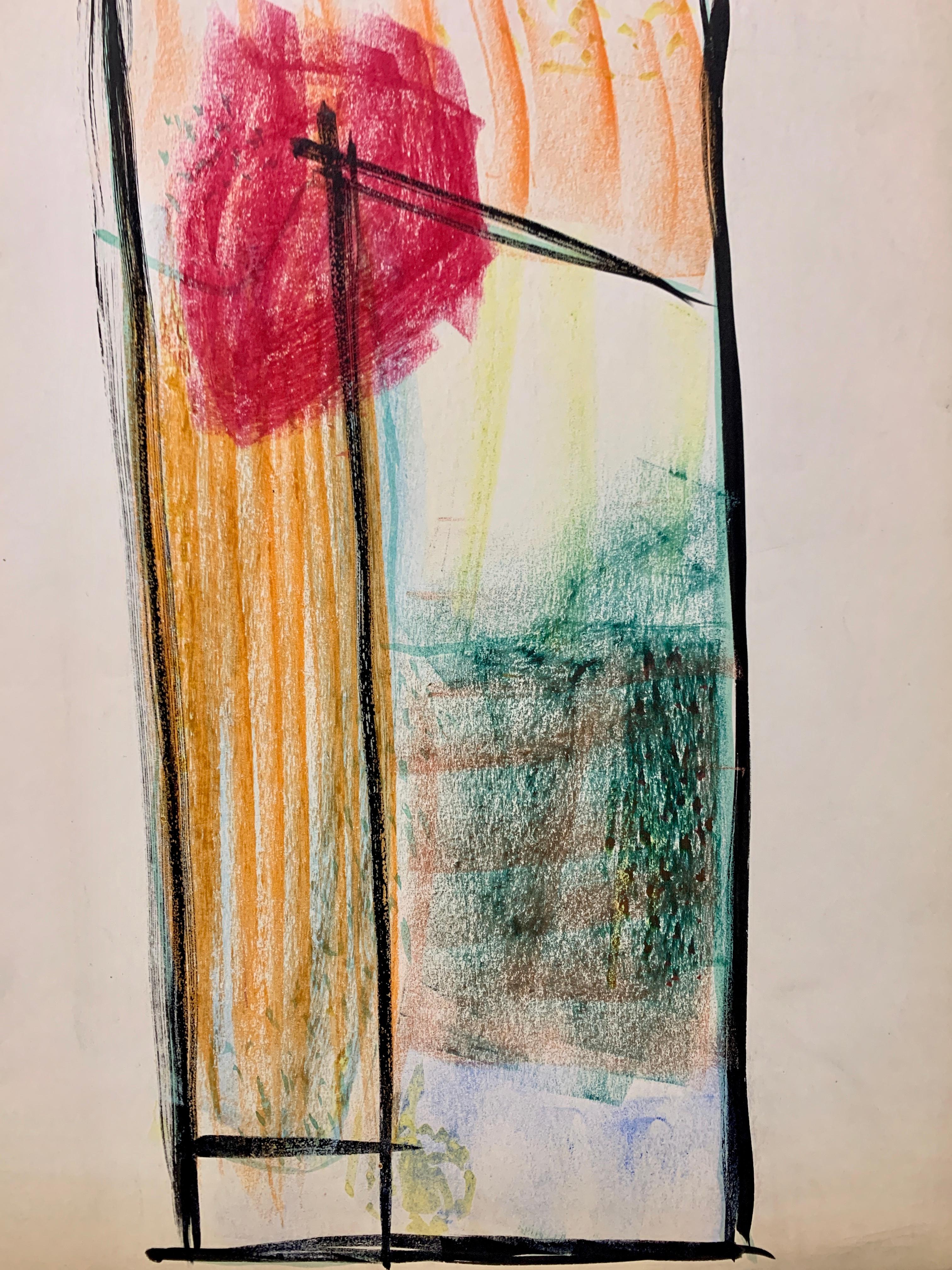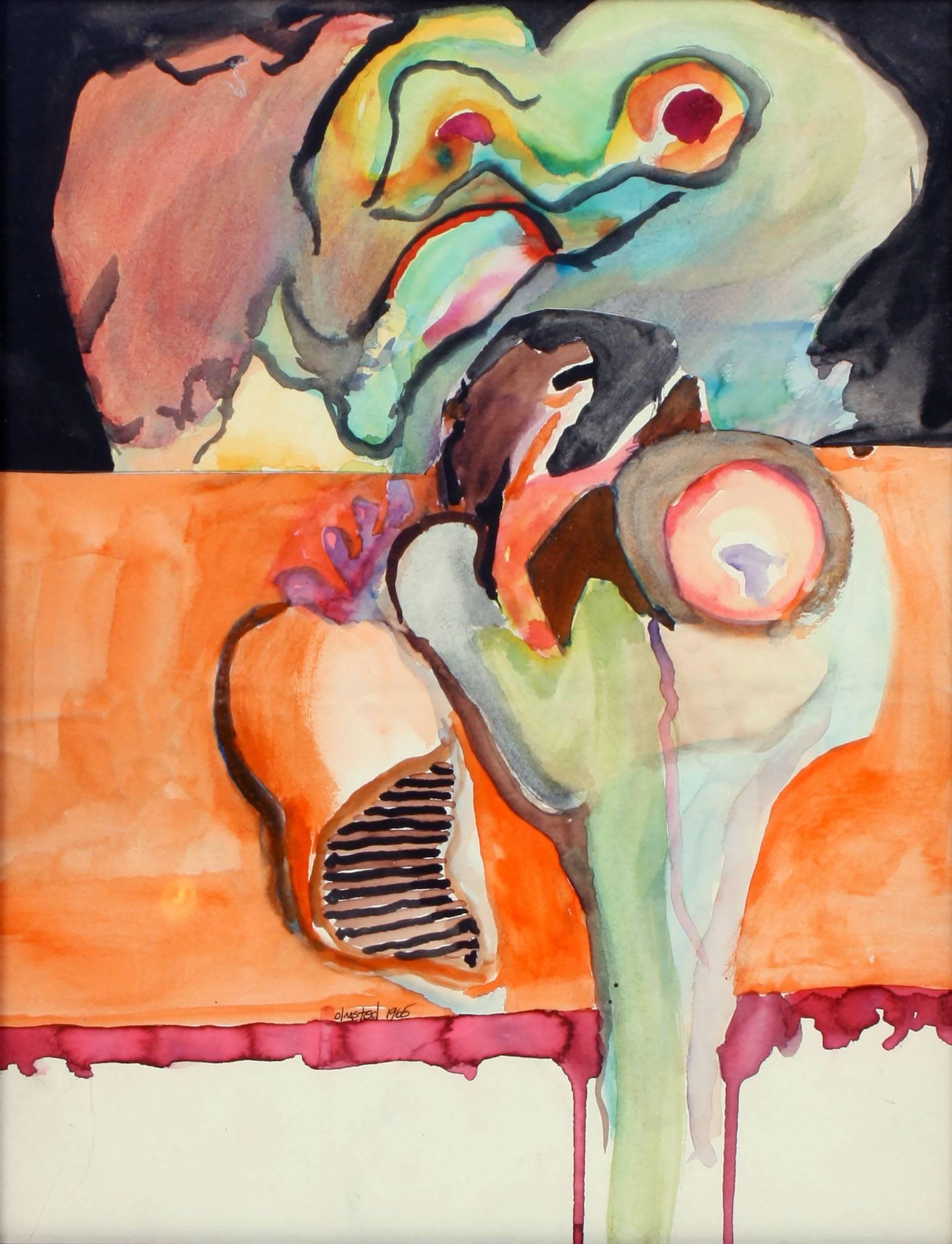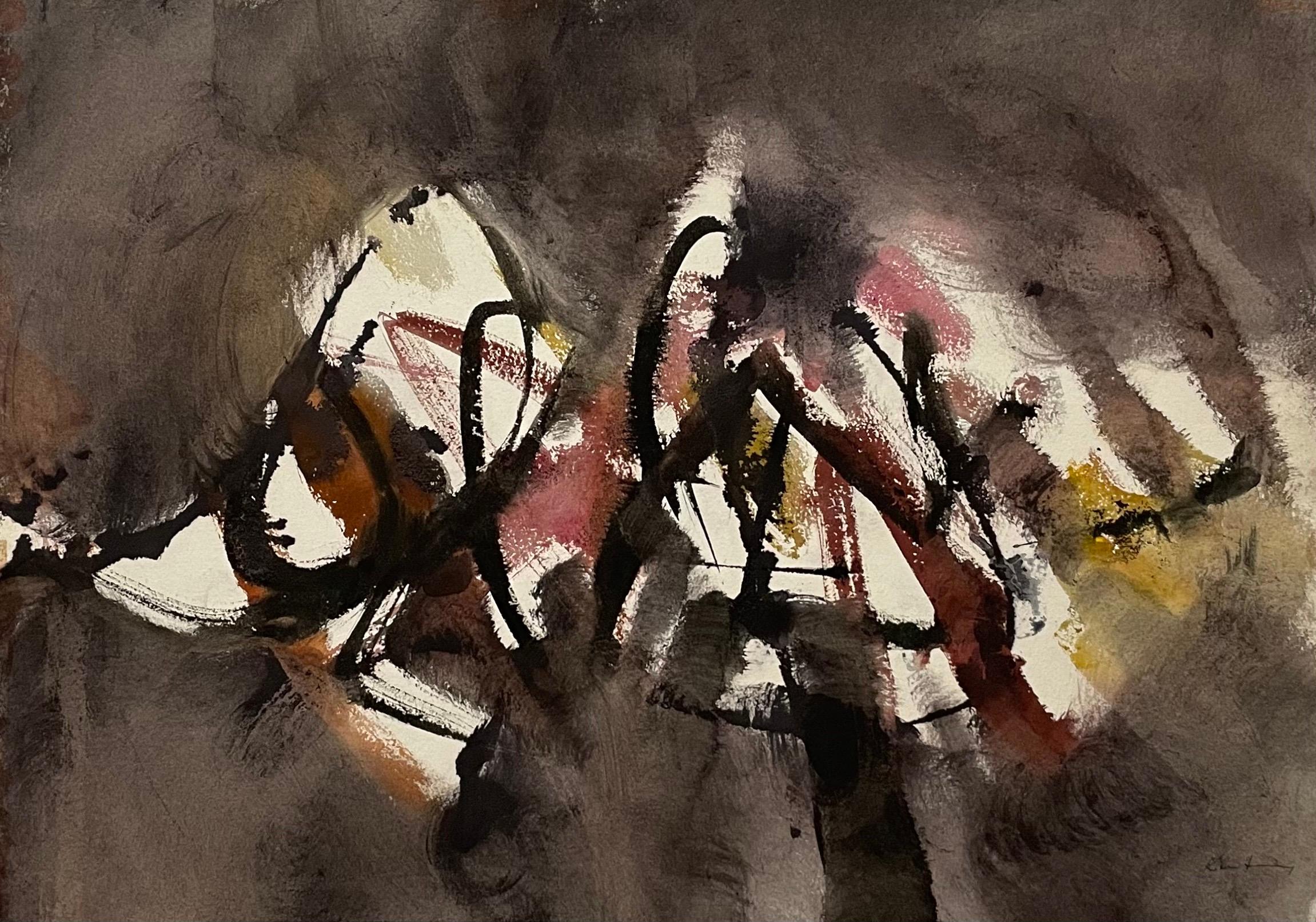Items Similar to Abstract Work on Paper Mid-Century Modernism Greek American Gouache Drawing
Want more images or videos?
Request additional images or videos from the seller
1 of 8
Jean XceronAbstract Work on Paper Mid-Century Modernism Greek American Gouache Drawing1949
1949
About the Item
Abstract Work on Paper Mid-Century Modernism Greek American Gouache Drawing.
A modernist artist who emigrated to America from Greece in 1904, when he was fourteen years old, Jean Xceron is described as having a reputation as an artist that has mysteriously fallen into obscurity---especially since he was reportedly quite prominent during his lifetime. However, a partial explanation of that omission is the fact that many of his papers and early records have been lost. He was a painter of biomorphic abstractions and did collages, which were influenced by Dadaism.
Xceron was active in New York City when modernism was gaining influence. Of him during this period, it was written that his artistic role was "a vital link between what is commonly termed as the first-generation (the Stieglitz group, the Synchromists, etc.) and second-generation, the American Abstract Artists, the Transcendental Painting Group . . ." (Vrachopoulos) Because the abstract influence that moved into the New York art world after World War I went into abeyance during World War II, Xceron somehow has gotten classified as part of the second generation but omitted as part of the pioneers. However, examination of his paintings and knowledge of his activities indicate he was consistent with his unique abstract style from 1916 to 1932. After that, his work became totally abstract.
He was born in Isary, Greece with the birth name of Yiannis Xirocostas. Upon arrival in America, he lived with various relatives around the country, and then between 1911 and 1912, studied at the Corcoran School of Art in Washington DC. At that point, he changed his surname to Xceron, and he was called John, which is the English translation for Yiannis. However, when he later studied in France, he was called Jean, the French equivalent of John, so those first names have been used interchangeably. The next year, after graduating from the Corcoran, Xceron moved to New York City.
He, like many of his artist peers, was much influenced by the 1913 Armory Show, a venue that made provided many Americans their first exposure to modernist or abstract art, much of it imported from France. At that time, Xceron was affiliated with the artists around Alfred Stieglitz, who was about the only promoter of modern art in America, something he did through his New York City Gallery 291. Borrowing some of the abstract Armory Show works that Stieglitz had obtained, Xceron and some colleagues staged their own exhibition in Washington DC. This marked him and his group as being rebels, that is in violation of academic methods prescribed by those who set those standards at the National Academy of Design.
Underscoring Xceron's commitment to non-traditional artwork was his membership in the Society of Independent Artists as well as his close association with Cubist painter Max Weber, Futurist painter Joseph Stella, and Dada Greek poet, Theodoros Dorros.
In 1927, he went to Paris to further his art career, which included study at the Ecole des Beaux Arts; he remained for ten years, leaving as World War II approached. He earned money by writing art reviews for the European editions of the Chicago Herald Tribune, the New York Herald Tribune, and the Boston Evening Transcript. In this capacity, he became a link as a writer between the European avant-garde and the American public. But he also did much artwork that aligned him with the French modernist movements, and by the time he returned to the United States, his work was totally abstract. In 1938, he joined the American Abstract Artists, a group that was quite controversial in the 1940s and 50s in America because it was so different from the prevalent American Scene painting.
Many of the Europeans artists fleeing Europe became associated with Xceron in New York City during the war years of the 1940s such as Fernand Leger and Piet Mondrian. In fact, Xceron was the person Mondrain first wrote to when he decided to leave Europe and needed help.
Xceron's work was added to the collection of the Museum of Modern Art; he received a mural commission for Riker's Island under the Federal Art Project; and in the 1940s and 1950s, he was employed in a Registrar capacity by Hilla Rebay at the Solomon R. Guggenheim Museum. In that position, he was able to do his own painting as well in his spare time, and he had gallery exhibitions and regular exposure at the Guggenheim in their non-objective shows. In the late 1940s and early 1950s, his work reflected Abstract Expressionism such as in the painting commission, Radar, he did for the University of Georgia.
The drawing measures 10 1/2 x 7 inches.
- Creator:Jean Xceron (1890 - 1967)
- Creation Year:1949
- Dimensions:Height: 24 in (60.96 cm)Width: 20 in (50.8 cm)Depth: 2 in (5.08 cm)
- Medium:
- Movement & Style:
- Period:
- Condition:
- Gallery Location:New York, NY
- Reference Number:1stDibs: LU115628324512
About the Seller
5.0
Platinum Seller
These expertly vetted sellers are 1stDibs' most experienced sellers and are rated highest by our customers.
Established in 2008
1stDibs seller since 2019
164 sales on 1stDibs
Typical response time: <1 hour
- ShippingRetrieving quote...Ships From: Pawling, NY
- Return PolicyA return for this item may be initiated within 3 days of delivery.
More From This SellerView All
- American Cubist Abstract Art Deco Avant-Garde Constructivism 20th Century ModernLocated in New York, NYAmerican Cubist Abstract Art Deco Avant-Garde Constructivism 20th Century Modern Florence Henri (American, 1893-1982) Composition 18 1/2 x 12 1/2 in...Category
1920s Abstract Abstract Paintings
MaterialsPaper, Gouache
- Italian Abstract Work on Paper Color Field Non-Objective European Mid-CenturyBy Piero DorazioLocated in New York, NYItalian Modern Abstract Work on Paper Color Field Non-Objective European Mid-Century - "Gonage" Dorazio completed "Gonage" in 1949 when just after the artist had been awarded a stipend by the French government and admission to the Academy Beaux Arts. There he met George Braque who became great friends but also an influence on Dorazio, of which "Gonage" is a living testament. "Gonage" actual size of the drawing measures 12 x 9 1/2 inches. It is signed on the lower right. The work is affixed to a 19 x 15 inch board which includes the artist's signature and date. There is a torn table on the lower left entitling the piece "Gonage". Provenance follows this piece as a gift in 1950 to the artist-colleague Luigi Lucioni, who then gifted it in 1955 to his friend, the uncle of the current owner who has owned the work since 1988. Bio Born in Italy, Piero Dorazio studied architecture in Rome. At the same time his first abstract works were executed. In 1947 he received a scholarship from the Ecole Nationale Supérieure des Beaux Arts in Paris, where he contacted Modern artists, who lived in Paris. He founded the galleries "Age d'Or" in Florence and Rome to represent avant-garde arts in Italy. During a one year stay in the USA he got acquainted with leading artists of Abstract Expressionism such as Marc Rothko...Category
1940s Abstract Abstract Drawings and Watercolors
MaterialsGouache, Board
- MODERNIST DRAWING New Hope Mid-Century WPA Abstract Non-Objective Jazz ModernBy Ramstonev (Ramsey/Stone/Evans co-operative)Located in New York, NYMODERNIST DRAWING New Hope Mid-Century WPA Abstract Non-Objective Jazz Modern. Signed with a "Ramstonev" stamp lower right. RAMSTONEV Cooperative Art Project (1937-1939). In the late 1930s, Charles Ramsey became close friends with Charles Evans and Louis Stone. He persuaded them to join him teaching his New Hope summer classes in non-objective painting. Soon, a history-making collaboration began. In 1937, meeting in Evans' studio at the rear of Cryer's Hardware store on Main Street in New Hope, a decision was made to establish the Co-Operative Painting Project. They were intrigued by the cooperative ad-lib process by which jazz musicians created their music. Believing this to be the quintessential American contribution to music, they theorized that a similar result might be obtainable with art, a "visual jam session." This particlarly fascinated Ramsey, who was a jazz buff and had a large collection of jazz records. The objective was to jointly collaborate in the creation of a painting as well as applying collective criticism during its creation. By creating forward movement by general consent, they believed they could produce a higher level of beauty. By consensus it was decided that subject matter would be non-objective. Up to eight people would participate and stop when the painting "felt" finished by common agreement. These co-operative works were done in several different mediums- the majority in pastel, but some in watercolor, gouache, graphite or cut paper collage. On occasion, the group would create a series, as opposed to a single work, created in steps by three or four artists. One of the occasional participants was famed New Hope poet, Stanley Kunitz. These series could range in number from four to sixteen paintings in each. The first of a series would be very basic and the last a fully finished work. In the scope of importance among the New Hope Modernist...Category
1930s American Modern Abstract Drawings and Watercolors
MaterialsGouache, Paper, Watercolor
- "NY Street Signs" Mid-20th Century WPA 1938 Modernist Abstract Realism Pop ArtBy Stuart DavisLocated in New York, NY"NY Street Signs" Mid-20th Century WPA 1938 Modernist Abstract Realism Pop Art Stuart Davis (American, 1892-1964) "Street Signs" Modernist gouache and traces of pencil on paper in t...Category
1930s American Modern Abstract Drawings and Watercolors
MaterialsPaper, Gouache, Pencil
- Abstract Mid 20th Century WPA Non Objective American Modernism New Hope ModernBy Louis StoneLocated in New York, NYAbstract Mid 20th Century WPA Non Objective American Modernism New Hope Modern.mixed media. 21 x 16 (sight). Housed in a hand carved frame. Louis King Stone ...Category
1940s American Modern Mixed Media
MaterialsGouache, Board
- Abstract Geometric WPA Painting Transcendental Art Modern Non Objective 1940sLocated in New York, NYBorn in Hungary, Bisttram went on to become a prolific artist creating many thousands of paintings and drawings that embraced styles from realism through abstraction. A member of the WPA, he was best known as one of the founders of Transcendental Art...Category
1940s Abstract Geometric Abstract Paintings
MaterialsPaper, Encaustic
You May Also Like
- 1950s "Sitting in Chair" Mid Century Figurative Pratt Graphic Arts CenterBy Donald StacyLocated in Arp, TXDonald Stacy "Sitting in Chair" c.1950s Gouache and oil pastel on paper 24" x 18" unframed Came from artist's estate *Custom framing available for additio...Category
Mid-20th Century American Modern Abstract Drawings and Watercolors
MaterialsPaper, Oil Pastel, Gouache
- 1950s "Rectangle" Mid Century Abstract Gouache PaintingLocated in Arp, TXOpper Estate Maroon Abstract c. 1940-1950's Gouache on Paper 15" x 18" Unframed From the estate of Ruth Friedmann Opper & Jerry Opper. Ruth was the daughter of Bauhaus artist, Gustav Friedmann. San Francisco Abstract Expression A free-spirited wave of creative energy swept through the San Francisco art community after World War II. Challenging accepted modes of painting, Abstract Expressionists produced highly experimental works that jolted the public out of its postwar complacency. Abstract Expressionism resulted from a broad collective impulse rather than the inspiration of a small band of New York artists. Documenting the interchanges between the East and West Coasts, she cites areas of mutual influence and shows the impact of San Francisco on the New York School, including artists such as Mark Rothko and Ad Reinhardt. San Francisco's Beat poets...Category
Mid-20th Century American Modern Abstract Paintings
MaterialsPaper, Gouache
- 1950s "Red Sun" Mid Century Abstract Art Students League NYCBy Donald StacyLocated in Arp, TXDonald Stacy "Red Sun" c.1950s Gouache and oil pastel on paper 13.75" x 17" unframed Unsigned Came from artist's estate *Custom framing available for additional charge. Please expect framing time between 3-5 weeks. Donald Stacy (1925-2008) New Jersey Studied: Newark School of Fine Art The Art Students League...Category
Mid-20th Century American Modern Abstract Drawings and Watercolors
MaterialsPaper, Oil Pastel, Gouache
- Study for Sculpture #2By David HayesLocated in Lawrence, NYGouache on paper signed en verso Throughout his sixty-year artistic career, David Hayes created sculptural forms abstracted from organic forms encountered in daily life. He first st...Category
1980s American Modern Abstract Drawings and Watercolors
MaterialsGouache
- Abstract LandscapeBy Wes OlmstedLocated in Buffalo, NYAn original watercolor painting by American artist Wes Olmsted depicting an abstract landscape view.Category
1960s American Modern Abstract Paintings
MaterialsArchival Paper, Watercolor
- Modernist Abstract Expressionist Watercolor Painting Bauhaus Weimar ArtistBy Pawel KontnyLocated in Surfside, FLAbstract watercolor composition bearing the influence of the earlier color-block compositions of Paul Klee. Pawel August Kontny, (Polish-German-American artist) He was born in Laurahuette, Poland, in 1923, the son of a wealthy pastry shop owner. In 1939 he began studying architecture in Breslau where he was introduced to the European masters and to the work of some of the German Expressionists, soon afterward banned as "degenerate artists" and removed from museums throughout Germany by the Nazi regime. His studies were interrupted by World War II. Drafted into the German army, traveling in many countries as a soldier, he sketched various landscapes but in 1945, he was captured and held as a prisoner of war in Italy. After the war, he studied at the Union of Nuremberg Architects to help design buildings to replace ones destroyed in the war. He recorded his impressions of the local population and the landscapes through his watercolors and drawings. Pawel Kontny thereafter moved to Nuremberg, Germany, becoming a member of the Union of Nuremberg Architects and helping to rebuild the city's historic center. He soon decided to concentrate on his professional art career. He married Irmgard Laurer, a dancer with the Nuremberg Opera. Pavel Kontny 's career as an artist was launched with his participation in an all German exhibition, held at the Dusseldorf Museum in 1952. He held one-man shows in Germany, Switzerland and the United States. During his trip to the United States in 1960, Kontny became instantly enamored with Colorado, and decided to relocate to Cherry Hills with his wife and two children. He quickly established himself in the local art community, being affiliated for a time with Denver Art Galleries and Saks Galleries. His subject matter became the Southwest. During this time he received the Prestigious Gold Medal of the Art Academy of Rome. His extensive travel provided material for the paintings he did using his hallmark marble dust technique. he also worked equally in pastel, watercolor, charcoal and pencil-and-ink. in a style which merged abstraction and realist styles, influenced by Abstract Expressionist painting and South Western American landscapes. In the early 1960s he was one of only a few European-born professional artists in the state, a select group that included Herbert Bayer (1900-1985), a member of the prewar Bauhaus in Weimar and Dessau, Germany, and Roland Detre (1903-2001), a Hungarian modernist painter. As a Denver, Colorado resident, Pavel Kontny exhibited at galleries and museums throughout the United States, Germany and Japan. There, he was inspired by frequent trips to Native American pueblos in the Southwest, as well as by the study of the Plains Indians of Montana and Wyoming. Over the years Kontny had a number of students and generously helped young artist by hosting exhibitions at his Cherry Hills home. For many years he generously donated his paintings to support charitable causes in Denver. Influences during his European years included German pastelist C.O. Muller, German Informel painter Karl Dahmen and Swiss artist, Hans Erni. In the early 1950s his painting style showed the influence of the Die Brücke (The Bridge), a group of German expressionist artists formed in Dresden in 1905 who had a major impact on the evolution of modern art in the twentieth century in Germany. By the middle of the decade his style incorporated more referential abstraction and total abstraction, resulting in part from his study of Hans Hartung, a German artist based in Paris who exhibited his gestural abstract work in Germany. His work also bears the influence of Sam Francis. The American moon landing in 1969 inspired Paul Kontny...Category
Mid-20th Century American Modern Abstract Drawings and Watercolors
MaterialsWatercolor, Archival Paper
Recently Viewed
View AllMore Ways To Browse
Midcentury Art Work
American Vintage France
Midcentury Early American
American Review
Greek American
French City Drawing
Early American Artwork
French Abstract Work On Paper
Modern Greek Art
Greece Art Modern
Greek Modern Art
Greek Mid Century
Greek Midcentury
Greek Framed
American School Mid Century
Mural Drawing
World War Ii American
Early Modernism





